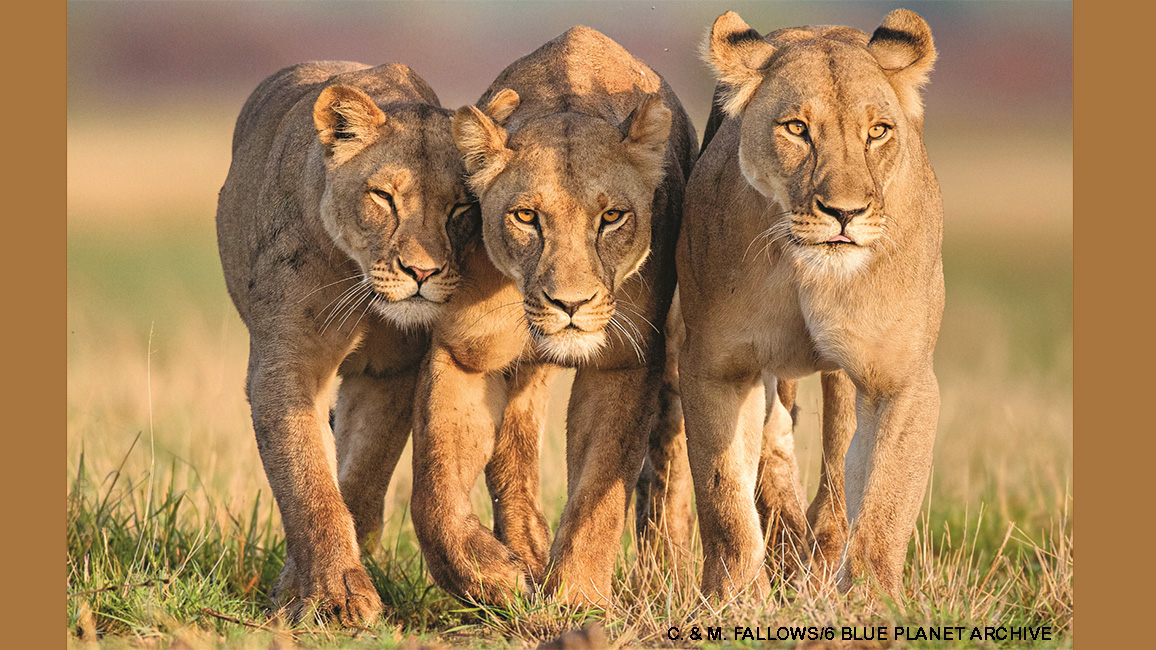
Lion Prides
By Anne CisselWhat’s the secret to a female lion’s success? Working well with others.
Check out these three female African lions. They look ready for action! A male lion, with his furry mane and loud roar, is sometimes called “King of Beasts.” But the “queens” get a lot of the work done in their pride, or lion group. And they know cooperation is the name of the game. Let’s take a look at how female lions, often called lionesses, team up to hunt, raise cubs, and keep the pride members roaring together.
NATURE NOTE: Ten thousand years ago, lions were found across most of the world. Now they live in far fewer places—in Africa (south of the Sahara desert) and in a small area in India.

HUNTING PARTY
Getting enough food to feed the pride is really important. That’s why lions hang out near their favorite prey: zebras, gazelles, impalas, buffalo, and other hoofed plant-eaters. These animals live in big herds. Lions need to be clever to catch one of these fast-moving creatures.
Male lions, with their big bodies and dark, showy manes, have a hard time sneaking up on prey. Sometimes the males catch prey, but females do most of the hunting for the pride. Female lions are smaller, faster, and can hide better in the savanna grasses. And they’re even more likely to catch something when they work together as a team.
Once the sun goes down and the air cools off, the hunt is on. Though lions can run fast for short bursts, most of their prey would outlast them in a chase. So, they try to sneak up as close as possible before attacking. The attack unfolds like a play in a football game. Each female lion usually has a favorite position on the “field.” Some will approach from the side. Others will stay still, then ambush the prey when it flees the other lions.

Even with all this strategy, the prey gets away most of the time. For every ten tries, lions succeed only about three times. And even once they have killed an animal, the work isn’t done. Vultures and hyenas are often nearby, looking to steal the lions’ kill. But the female lions guard their meal and try to keep the thieves away.
The other members of the pride soon know that dinner is ready, and they all come to chow down. But lions aren’t very good at sharing. The males use their bigger size to push the others aside and take their portions first. Then the females dig in, and the cubs get the leftovers.
BIG MEAL: If it hasn’t eaten for a long time, a lion can gobble up more than 65 pounds of meat at once!

PRIDE LIFE
Most kinds of wild cats live alone, but lions are all about group living. There are usually about 15 lions in a pride. It’s made up mostly of females and cubs, and up to four males. The male lions do have a big job. They patrol the borders of their territory and fight off other lions trying to take over the pride. They roar and spray urine to say, “This is MY turf.” A male’s roar can be heard up to five miles away.
But lions can be very loving toward their fellow pride members. They greet each other by rubbing heads and licking each other. And even though hunting and protecting their territory are big jobs, lions sleep for about 20 hours a day. This helps them save energy for when they really need it.

CUB DAYCARE
Another big job for the females is raising cubs. Females usually all have babies at the same time of year, so they work together to care for the young. They even nurse each other’s cubs. Sharing the cub care means that some females can go hunt while others stay home to “babysit.” Once the female cubs are grown, they stay in their mothers’ pride. This means that all the females in the pride are related to each other. After about three years, the young males leave the pride to lead their own separate lives.
PROTECTING LIONS
As tough as lions are, there are far fewer of them around than there used to be. People have built farms, towns, and roads in the places lions used to live. But the biggest problem is landowners who kill lions to protect their own farm animals.
Female lions give us a good example of working together. It’ll take a lot of human teamwork to help lions roar into the future!
WATCH: A Day with Lila the Lioness

















